.
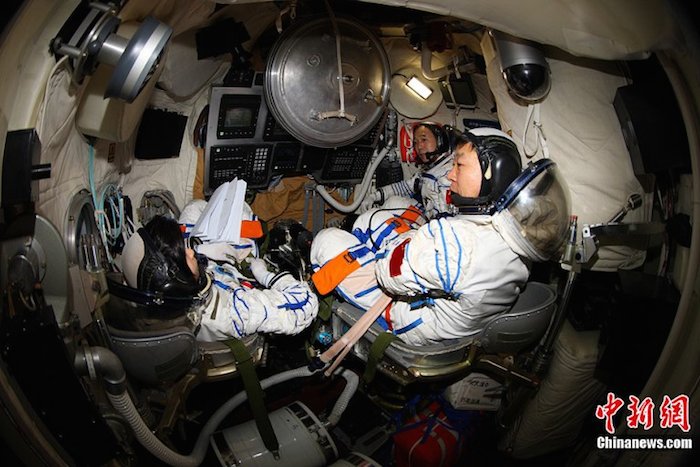
The crew of the 2012 Shenzhou-9 mission to Tiangong-1 in training. (Photo: CNS)
-
The chief designer of China's human space program has revealed new details on the country’s first space station, which will be completed around 2020.
Zhou Jianping, speaking to state media on the sidelines of China’s ongoing parliamentary sessions, explained that the project will include three modules, two 30m solar panel 'wings', two robotic arms and a telescope dubbed 'China's Hubble'.
Zhou, who is a member of China’s top consultative body currently in session in Beijing, said the space station will comprise of a core module and two labs forming a T-shape, each weighing about 20 tons.
The core module is scheduled to be launched in 2018, by the new heavy lift Long March 5 rocket, which will make its maiden flight in September and be capable of lifting 25 tonnes to low Earth orbit.
The core module will have five docking interfaces, including one for 'Tianzhou' cargo ships, two for crewed spacecraft, and two space lab modules.
.
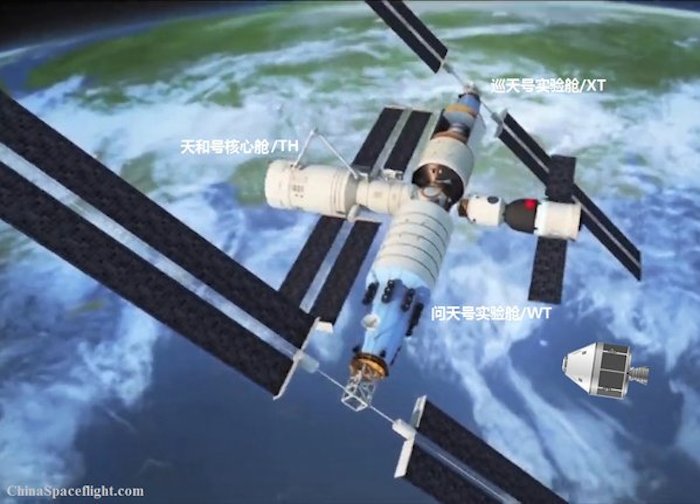
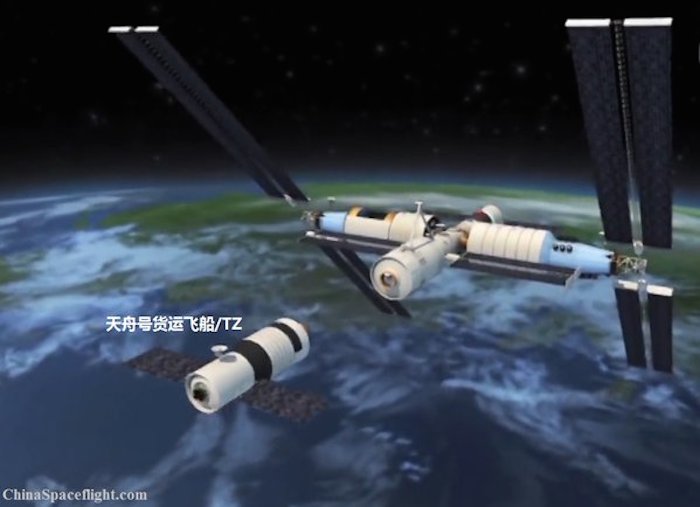
China’s space station will have two flexible solar arrays, or 'wings’, each with a 30-metre wingspan.
“Together with biaxial sun pointing mechanisms and high-efficient lithium ion battery, they constitute a sophisticated and powerful space station power system," Zhou said.
The station will also have two robotic arms, with a total length of 15 metres. Zhou notes that human-machine coordination will make the building and maintaining of the Space Station possible.
‘China’s Hubble’
An ‘optical module’ will also be part of the Chinese space station, according to Zhang Yulin, a senior military official and a deputy to the National People’s Congress.
According People's Daily, Zhang said the two-metre diameter optical module will orbit in proximity to the space station, making it easily accessible to astronauts for repair and maintenance.
The module is expected to provide a level of resolution no less than the famous Hubble space telescope, but with a field of view 300 times larger.
If it remains active in orbit for a decade, the telescope could be able to cover around 17,500 square degrees of space, or 40% of the sky.
It is hoped that China will make breakthroughs related to the origin, development and evolution of the universe with data gathered.
Space science, exploration and preparation
“The mission of the space station is to become China’s national laboratory in space and support scientists’ work on cutting-edge scientific exploration, space technology research and development and utilisation of space resources. The ultimate goal is to benefit all of humanity,” Zhou said.
“Recycling materials and increasing the ratio of recycled materials are major technological challenges for the world’s crewed space flight missions,” Zhou said.
The Tiangong-2 space laboratory, set to be launched later this year and be visited two astronauts for 30 days on the Shenzhou-11 mission in the fourth quarter of 2016, will thus be used to advance knowledge and techniques required for long-term stays on the future space station.
.
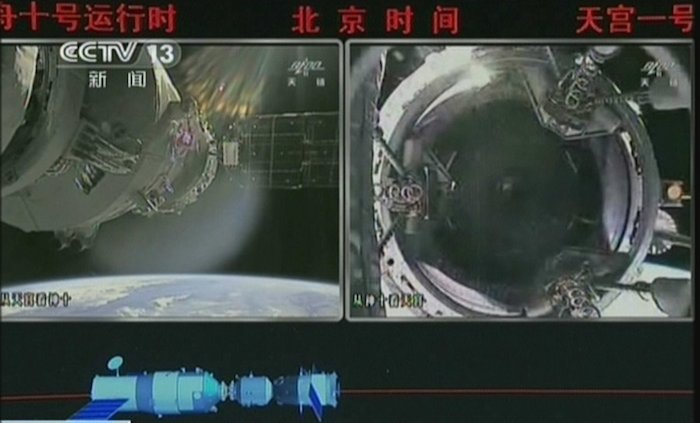
Above: Shenzhou-10 rendezvous and docking with Tiangong-1 in 2013.
Shenzhou-12 is expected to follow after China’s first ever cargo resupply mission to the lab, Tianzhou-1, in early 2017.
The Tianzhou-1 resupply mission needs to be launched by a new Long March 7 rocket, which will make its first flight in June from Wenchang, and greatly boosts China’s launch capabilities.
"After the Tiangong-2 mission is completed, China will start the construction of its space station, which will be completed around 2020. It will be a large, complicated and advanced space facility for astronauts to live and work in space," Zhou said.
“Future space exploration requires people to live in space for a long time. To explore technologies about closed-loop ecological systems in space, Tiangong-2 will conduct “from-seed-to-seed” experiments which involve plants’ entire growth and development process.
“At present, we plan to plant rice and cress to observe different growth under the long-day and short-day scenarios”, Zhou said.
.
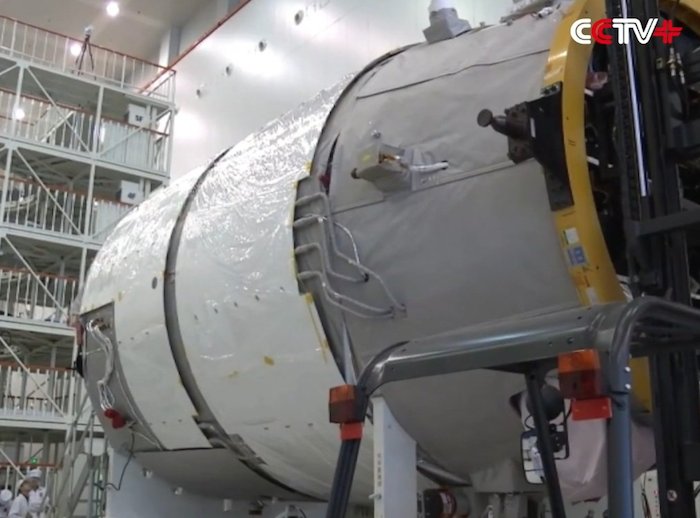
Above: A framegrab from a recent CCTV video showing Tiangong-2 under development.
Overall, Tiangong-2 will host 14 scientific payloads and experiments to carry out research in areas including space life science, fluid physics in microgravity, fundamental physics, Earth science, space astronomy, and the space environment.
For the space station, Zhou hopes that the” experimental facilities for material science can make use of microgravity in space to make new materials and research their functional performance.
“Lots of studies in future will focus on the research and development of new materials. The new materials will have great industrial values,” Zhou said, adding that the advanced space research platform can provide an environment for scientists to make major world-class breakthroughs.
New astronauts
With long duration stays in space and vast scientific agenda, China’s space station will bring new demands and possibilities, which will be reflected in the astronauts trained for missions.
“Astronauts will need to carry out a greater variety of missions than before, so a greater variety of astronauts are needed,” said Zhou.
“We've been selecting astronauts mainly from pilots, and now we will also select them from flight engineers and space technology experts. You can see a change in the groups of people we select from.”
Wang Weifen, deputy director of China's Astronaut Centre, said in 2014 that this third batch of astronauts will include doctors, psychologists and engineers from departments relevant to human spaceflight research, along with air force pilots, which made up the first two batches.
The only show in orbit?
Based on the timeline above, China's space station may become the only orbiting station shortly after completion, with the International Space Station currently set to ends its mission in 2024.
Incidentally, the timeframe given for completion of China’s space station has moved a number of times over the past years.
Having been slated for 2020, it had seemingly slipped to 2022 or 2023, according to quotes from officials. The more ambitious target of 2020 has been reinstated, with a mooted third Tiangong space lab seemingly dropped from the scheduled.
Quelle: gbtimes
4120 Views
